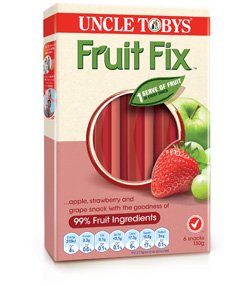
I’m nothing if not responsive to reader requests. Richard Andersen has written to express some concerns about my recent post on Uncle Toby’s Fruit Fix bar. Richard is General Counsel (a lawyer) for Nestle Australia Ltd and he says that Nestle is worried that you might have misunderstood some things in my post. So in the interests of clarity and fairness, in this post, I’ll go through each of Nestle’s concerns and correct the record.
Righto, off we go – Nestle says that I “represent[ed] … that the Fruit Fix Strawberry variant contains only strawberries … The front of pack clearly describes the product as ‘… apple, strawberry and grape snack’, which you have failed to mention in your post.”
Well true enuff Richard, you’ve got me there mate. I didn’t recite the front label of the pack. I just went ahead and referred to the product by the name Uncle Toby’s used to describe it on their site (I didn’t actually buy a packet of the stuff!). So for the record folks, Fruit Fix Strawberry is an apple, strawberry and grape snack. It does not under any circumstances contain just strawberries, so don’t go thinking it does.
Richard then says that Nestle is concerned that comparing the sugar content of a strawberry to a fruit fix is misleading because Fruit Fix also contains apples and grapes. I don’t want anyone being mislead so here is the full comparison (including apples and grapes – SFF is Strawberry Fruit Fix):
Protein: Strawberry 1% Apple 0% Grape 1% SFF 1.3%
Fat: Strawberry 0% Apple 0% Grape 0% SFF .5%
Sugar: Strawberry 4.6% Apple 10.4% Grape 15.5% SFF 72.7%
Fibre: Strawberry 2% Apple 2.4% Grape .9% SFF 7.3%
The highest sugar concentration is 15.5% which is still a long way from 72.7% so I’m not sure what point Nestle is trying to make. Even if Strawberry Fruit Fix contained nothing but grapes, you’d still need to eat almost half a kilo of them to get as much sugar as 100g of Fruit Fix, but there you go, full disclosure.
Next Nestle was concerned that I “… make an inference that additional sugar has been added to the product … The product uses fruit puree and juice, which are inherently high in natural fruit sugars”.Notice how they underlined the word natural, I think it must be a magic word. Lawyers always underline magic lawyer words.
I can’t see where I have suggested that sugar is ‘added’ in the original post. But just in case anyone is confused, I unequivocally state that I don’t think any ‘additional sugar has been added to the product’. There’d be barely any room for anything else if they did, given all the sugar that’s already there.
No, I’m happy to accept Nestle’s word that the sugar in Fruit Fix comes entirely from fruit. Nestle seems to think that a molecule of sugar that was in some way associated with a piece of fruit in a prior life is an entirely different kettle of fish than one which found its genesis in a piece of sugar cane (like grapes, sugar cane is about 15% sugar in its natural state). I think this must be some sort of grass-ism (sugar cane is a grass).Nestle appear to believe that fructose molecules from fruit come from a better neighbourhood than those from grass. Apparently once being part of a piece fruit earns them the special label ‘natural’ as opposed to those (I guess) unnatural ones which were once part of a piece of sugar cane.
Nestle also takes exception to me suggesting that they are telling lies by emblazoning their product with ‘1 Serve of Fruit’ and advertising the product as a healthy and nutritious snack. They point out that unlike me, Nestle have carefully ensured they know the legal definition of the word ‘fruit’.
Silly old me. You see when someone says ‘1 Serve of Fruit’, I think of an apple or maybe a banana. But that’s where I’ve gone wrong according to Nestle. No, what I should be doing is reaching for my handy copy of The Australian Guide to Healthy Eating where I will discover (once I drill down to the fine print) that fruit juice and fruit puree are also considered to fit the definition of ‘fruit’. Since Fruit Fix is made from both of those ingredients, it is therefore ‘fruit’.
So when you define the words just the right way, Nestle is telling God’s honest. Personally I think it would be more honest to emblazon the box with ‘Five to Sixteen equivalent serves of sugars that were once part of a piece of fruit’ but I can see how the Nestle marketing people might not go for that.
Unfortunately Nestle didn’t give me their definition of ‘healthy and nutritious’ so I’ll just have to rely on common sense for that one. I take the phrase to mean the food will promote good health (or at least not bad health). And this is where Nestle and I will have to disagree on the ‘truth’. Nestle maintains that a food which is almost three quarters sugar (and the majority of that, fructose) promotes good health. But there over 3,000 published studies which say exactly the opposite.
The latest one (published just last month in the Journal of Clinical Investigation) reported on a study at the University of California where 32 overweight and obese people were persuaded to try a 10 week diet which was either 25 percent fructose or 25 percent glucose. Fructose and glucose are the two sugars that bind together to make table sugar. So ‘sugar’ is half fructose and half glucose (yes, even when it comes from fruit rather than cane).
The people on the fructose diet ended up with increased (1.5kg) abdominal fat, higher triglyceride levels (which leads to heart disease) and 20 percent higher insulin resistance (which leads to Type II Diabetes) after just 10 weeks! None of this happened to the group on glucose.
The University of California research is just the latest in a long line of studies which say the same thing. Sugar (or at least the fructose half or it) is highly dangerous to humans. And there is no shortage of research which shows that fat in the blood (the higher triglyceride levels) from fructose leads to obesity, heart disease and type II diabetes.
The ‘sugar’ in the Fruit Fix is likely to contain significantly more fructose than table sugar, coming as it does from condensed fruit juices. So Nestle are telling parents that it’s good to feed their kids something which consists of large amount of a substance which has been proven to cause obesity, heart disease and diabetes (to name a few of the problems). That does not fit my definition of ‘healthy and nutritious’, so in that sense I believe Nestle is lying when it says that Fruit Fix is a ‘healthy and nutritious’ alternative to fruit.
I guess to lie you must know that what you’re saying is not true. And I have assumed that Nestle would be aware of the research on fructose. I do sincerely hope that their defence (as one of our biggest food suppliers) is not that they weren’t aware of the dangers of sugar.
It’s a free country. Nestle has just as much right to sell high sugar, fruit flavoured confectionary as the next guy (actually a Mars Bar, for example, has considerably less sugar – ‘just’ 55.3%). What they should not do is tell us that it is a healthy and nutritious snack while they’re at it. And the Heart Foundation shouldn’t be aiding and abetting this deceit by stamping the product with its Tick of approval.

















Well said!
[…] lawyers have demanded that I correct this post – see the correction before you read […]
glad to see you got it right in the end David, couldnt have anyone confused by your clearly deceptive post… Im safe tho, I boycotted Nestle and ALL is associated food labels in the 80s when I FELT they were contributing to formula feeding babies that should have been breastfed.
In addition I gave up sugar in all it’s -ose forms 3 yrs ago. Lost 34kg, ditched my epilepsy and antidepressant meds and well so far I havent felt deprived or whatever the latest “thing” is about removing “entire food groups” from my diet.
Whatever, haters gonna hate and lawyers gonna lawyer… whatever THAT means…. Love your work!